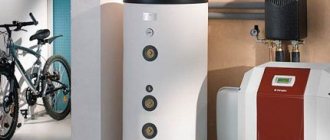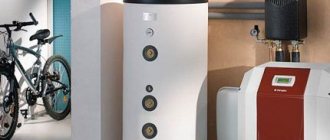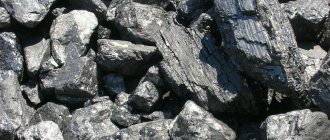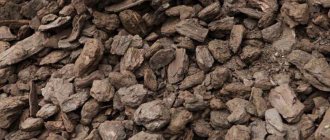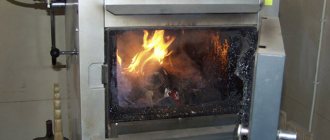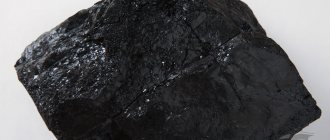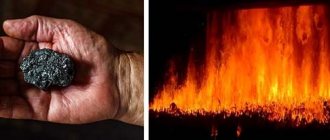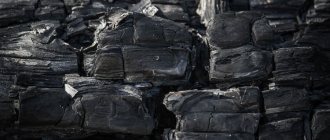Solid fuel boilers of individual manufacturers and brands operate without problems on various fuels, however, before purchasing a large amount of coal, it would not hurt to find out which type is best suited for use. As a rule, information about recommended products allowed for kindling is contained in the instructions for the unit. If for some reason it is not possible to obtain reliable information from the boiler manufacturer, then it is enough to purchase a bag of fuel of different grades and fractions, and then experimentally select the most effective one.
How and what kind of coal is best to heat a solid fuel boiler
Several grades of hard and brown coal are usually offered for household consumption; in addition, charcoal is also used. But, before loading the firebox with new fuel, you must carefully read the instructions for using the solid fuel boiler; it contains the brands of fuel recommended by the manufacturer.
For domestic and industrial heating boilers, the documentation indicates the optimal grades of coal for use. The fact is that during the production of boilers, finished products are tested and certified for use with different types of fuel. The heat capacity of coal of one group may be higher than the heat capacity of the brands recommended by the manufacturer, which is why the normal operation of the equipment may be at risk.
One of the conditions for how to properly fire a boiler with coal is the correct choice of fuel; in addition to indicating the type and brand, manufacturers recommend focusing on the amount of harmful impurities, dust, ash content and calorific value. This information is indicated in the fuel passport, but what specific qualities a particular brand has is worth finding out in more detail.
Coal
This type of coal is the most common. In most brands, the calorific value averages about 5500-6000 kcal/kg. This indicator is associated with a high hydrocarbon content; this substance makes up about 75% of the mass. When burned, coal produces from 2 to 5% ash, but it is worth saying that this applies to a high-quality product that has been cleaned from rock. Coal grades are divided by fraction size, weight and calorific value. In addition, there is a gradation based on how quickly the fuel burns. Almost all grades of coal are suitable for firing universal solid fuel boilers of the classic type. But such fuel is not suitable for long-burning devices; it has a rather high temperature index, which has a detrimental effect on the equipment.
Brown coal
This fuel is mainly used in the areas where it is mined. It so happened historically that brown coals were not widely used and are mainly a product of local consumption. The calorific value of brown coal is lower than that of hard coal, it is approximately 3000-3200 kcal/kg, this figure is almost 2 times lower than that of the lowest grade of hard coal. A special feature of this product is that after combustion it leaves more ash. In domestic heating installations, brown coal is used, and briquettes made from it with a mass fraction of humidity of about 50%.
Anthracite
When choosing a fuel with the highest calorific value, you should focus on anthracite, one of the best types of coal for combustion in a boiler. The calorific value allows the release of 9000 kcal/kg during combustion, which is one of the highest values. However, after combustion, anthracite forms a large amount of ash, up to 7%, and up to 5-7% of coal that is not burned.
Lignite
This type of coal raw material is intended for consumption in industrial installations. Many manufacturers do not recommend using it in everyday life due to its specific structure and large amount of ash residue.
Coal processing products
Conventionally, these types of products are difficult to attribute to any type of solid fuel made from natural hydrocarbons, but it is also quite difficult to ignore them. This type of product includes coal processing products - coal briquettes and coke.
The first is a briquetted type of fuel obtained by pressing waste from coal recovery at processing plants. Simply put, this is a pressed fine fraction of graded coal that remains after sifting the main mass. Such fuel is mainly used in industrial enterprises, since during combustion it releases a large amount of sulfur, and the ash content in the residue often exceeds 10% of the initial mass.
Coal dust in its pure form is practically not used in individual heating systems, since the technology of burning dust in solid fuel household boilers is not provided. In industrial production, in the energy sector with thermal generation and even in metallurgy, the use of dust is justified; it, in the form of a water-dust mixture, competitively replaces expensive natural gas, but in small boilers designed for 7-15 kW of power, this method is too expensive.
Coking coal, which is the main fuel for blast furnace production of pig iron, can be successfully used at home. However, you need to remember that the energy value ranges from 5.6 to 7.0 thousand kcal/kg. The average ash content is about 8%, volatile substances from 3.2 to 4.2%, sulfur in coke is 1-2%. Pure carbon makes up at least 87% of the substance.
Gas coal
This type of coal is often called flammable coal in everyday life. Saturated with light flammable gases, coal of this group has a small fraction, only 3, maximum 4 cm in diameter. This product is excellent for kindling, because it quickly begins to maintain combustion and also quickly raises the combustion temperature to 400-600 degrees, which is quite enough to ignite the bulk of the main fuel coals. But it’s unlikely to be used for a full-fledged combustion chamber; its calorific value is low, and the combustion time is 4-5 times higher than that of anthracite or coke.
Charcoal
Until the recent past, charcoal was one of the most common coal products. Today this coal has given way to hard coal, but it still remains in demand in private households. When burned, it produces from 7000 to 8000 kcal/kg, which is a good indicator compared to ordinary firewood. After combustion of 84% carbon, 2 to 2.8% ash is formed. It is especially good to use charcoal in solid fuel pyrolysis boilers and long-burning boilers.
Which is better, coal or gas?
It is generally accepted that the most profitable option for heating is main gas.
However, having learned the cost of supply and connection, many residents are looking for alternative heating options. It is better to compare these types of fuel according to three criteria:
- Energy. When burning 1 m3 (0.62 kg) of natural gas, you will receive 9.45 kW/h of heat without taking into account the boiler efficiency. A kilogram of anthracite will give 7.16 kW/h.
- Economic. Tariffs for the population for gas supplies are taken into account, as well as the cost of transporting coal and the efficiency of boilers.
- Ease of use. In all cases, a chimney and ventilation will be required. Storage of coal fuel requires space; it will have to be stored manually, while gas is supplied through a pipeline.
Reference. If the house is already connected to the gas main, then you don’t have to look for a more profitable heating method. If there is no connection, the best option is coal boilers operating in automatic mode.
How to heat a boiler from theory to practice
Getting the optimal result when burning coal depends on how correctly the technology of all stages of the combustion process is carried out, from loading firewood to replenishing the main fuel in the firebox. Success largely depends on how to light the boiler. The fact is that coal, anthracite or coke, enter the combustion process when the temperature in the combustion center reaches 400-600 degrees. It is simply impossible to achieve this with paper, and solid fuel itself will not be ignited by the fire of a match or a sheet of paper.
Coal storage rules
The shelf life of coal depends on the brand, deposit and environmental conditions. The best chance of maintaining all the properties of the fuel is when storing anthracite and semi-anthracite. With sizes from 70 cm to 100 mm, this coal is stored without loss of quality for up to 36 months, and with sizes from 100 mm - about a year. If you order coal for delivery, then plan the volumes you use to avoid loss of quality.
It is best to place coal in a covered room (barn, dry basement), where the rays of the sun do not penetrate. Coal oxidation begins at a temperature of 20-25 °C. At 40 °C weathering begins, which can be seen by a decrease in the size of the pieces. It is also necessary to periodically check the condition of the coal, since, for example, brown and porous stones are capable of spontaneous combustion. The combustion temperature for brown is 40-60 °C, fatty - 60-70 °C, lean and anthracite - from 70 °C.
It is not recommended to water heaped fuel, since when wet it allows oxygen to pass through better and oxidizes faster. To prevent fire, it is best to cover the coal with a tarpaulin.
The process of igniting a solid fuel heating boiler
The technology for igniting a solid fuel boiler is no different from the process of igniting a boiler with wood. There are just some nuances here. The first nuance is that a special grill for coal fuel must be installed in the lower part of the firebox. The purpose of this grate is that it allows the coals to be mixed during combustion. It is made in the form of a massive cast iron casting with a distance between the grates of 1.5-2 cm. This grate is installed vertically in the lower part of the firebox, and is closed by a blower door with a gate that regulates the oxygen supply.
Paper is placed in the lower part, on top of which wood chips are laid. The next layer includes splinters and small logs to ignite an active flame. 4-5 large logs are laid on top. The top layer is laid so that coal can be poured onto it, and at the same time, fuel does not spill into the blower.
For kindling, softwood chips are taken, it quickly flares up, maintaining combustion, creating sufficient temperature for the hardwood logs to ignite. Hardwoods are used as firewood - oak, birch, hornbeam; they create the necessary temperature to light the coal.
For the first laying, fine coal is used - with a diameter of 3-4 cm; the ideal option here would be gas coal or flammable coal.
It is important to remember that dry wood is used for ignition. Under no circumstances should flammable mixtures or liquid fuel be used. If you pour gasoline, biofuel or diesel into the firebox, there is a high probability that it will spill into the duct and even leak onto the floor. In this case, a fire cannot be avoided. It is better to put more crumpled paper at the bottom than to add even a drop of gasoline.
You can light a fire with a match or a lighter, there is no difference, the main thing is that the fire engulfs the wood chips and the top logs as quickly as possible.
How much coal is needed for the winter?
In order not to be left without fuel in severe frosts and not to think about where to put coal in the summer, it is necessary to evaluate a number of parameters before purchasing this or that volume.
These include:
- room area, wall material and insulation thickness;
- type of windows, doors, degree of ventilation;
- type of fuel, boiler, coal laying scheme;
- temperature changes in the region, duration of cold weather.
As practice shows, heating a brick house requires 35% more fuel than heating a wooden or aerated concrete block building. This is due to the fact that brick, due to its characteristics, takes away some of the heat. Approximately for a house with an area of 90 square meters, built of slag concrete with a wall thickness of 45 cm, with stove heating you will need from 2.5 to 3.5 tons of coal (2/3 of the volume is “seed”, the rest is anthracite “nut”) depending on changing temperature. If such a structure does not have additional insulation, then the amount of fuel purchased will already be at least 6-7 tons. Wooden house made of timber with an area of 80 sq.m. at a minimum temperature in winter of up to -40 °C (about 1.5 months and up to -20 °C the rest of the time), you will have to heat it with 5 tons of coal and 5 tons of firewood.
Main combustion period
Conventionally, the process of how to properly heat a boiler with coal can be divided into several stages - the first ignition, the second period of main combustion, the stage of achieving stable combustion and finally, attenuation.
The main period of combustion usually occurs at the moment when the firewood forms productive coals for backfilling the stone fuel. How to properly heat a solid fuel boiler depends on when the moment of filling the first portion of fuel is chosen. In terms of time, from the moment the paper begins to burn until the logs of the main tree are engulfed in flames, it usually takes 4-5 minutes, but this is with normal draft and an open blower damper. You can check what is happening in the firebox by opening the firebox door - when opened carefully, the firebox will be illuminated with an even, bright flame, which means that the time has come to add the first portion of coal.
First, fine coal 2-4 cm in diameter is poured into the firebox. At approximately this stage you will need from 0.5 to 1 kg of fuel or 1-2 scoops. Coal is poured through the fire door and made so that its layer is evenly distributed over the entire fire area. Immediately after backfilling, the door closes, and the valve on the vent door opens slightly to increase the access of oxygen to the combustion space.
It’s worth checking what’s happening in the firebox after 10-12 minutes. This time is enough for the temperature to rise to 400 degrees and the fuel begins to burn, releasing enough heat. During this period, it is worth paying attention to the readings of the thermometer on the boiler; if the temperature rises sharply and the coolant begins to heat up better in the pipes and radiators, it means that it is time to supplement the boiler with another portion of fuel.
According to the rules of how to properly heat a boiler with coal, you need to add from 3 to 5 kg of anthracite or medium-fraction hard coal. The coals should be of average size 4-7 cm in diameter. Just like fuel, filling is done through the combustion door with a spatula or scoop. If possible, the coal is scattered over the entire area of the firebox so that the layer is about 10-15 cm (however, much depends on the size of the firebox). After the firebox door is closed, the thermostat is set and the boiler is switched to long-burning mode, when it itself regulates the opening and closing of the oxygen supply valve.
Equipment disadvantages
Despite its advantages, a long-burning coal boiler also has disadvantages. The most important disadvantage is the need to constantly monitor the fuel combustion process when the model does not have a built-in thermostat and other equipment that regulates the operation of the entire system.
Boilers with a small firebox volume require frequent addition of a new portion of coal, which is also inconvenient, especially for those who are at work most of the day and do not have the opportunity to control the process.
It is also worth noting that more modern models are expensive and not everyone can install them.
For some people, the disadvantage of the device may be the inability to add an additional portion of fuel while the previous one is burning. This applies to pyrolysis models, in which combustion occurs from top to bottom. If a simple model with bottom air supply is installed, adding coal is possible.
An automated system also has a disadvantage, since frequent power outages or low voltage may cause it to fail. That is why in rural areas, where such problems are constantly observed, it is recommended to install simple models that do not depend on the source of electricity. Despite all the shortcomings, long-burning boilers are very popular; there is no alternative to them in the absence of gas.
Stable combustion stage
The stable combustion stage lasts about 5-9 hours. The main technique on how to properly heat a boiler during this period is to uniformly supply fuel to the firebox. Usually, if at the first filling ¼ of the fuel is used, then during the period of maintaining stable combustion, the remaining fuel is divided into 3 equal parts. After adding anthracite through the vent grate, the burning mass is stirred to prevent slagging of the firebox.
Operating rules
For the smooth operation of the heating device, it is necessary to follow several rules that will help extend its service life. It will not be possible to ignite the coal directly, since this requires a temperature of at least +400 °C. This is why it is necessary to use firewood for the fire.
When burning wood, it is recommended to leave all valves open to ensure air access. After some time, the firewood burns down to smoldering logs.
It is necessary to pour coal on them in a layer, the thickness of which is no more than 15 cm. After flaring up, you can add more of it. It is recommended to use pieces of approximately the same size.
To prevent the water in the boiler from boiling, you should control the combustion and, if necessary, close all dampers. For the boiler to operate efficiently, the ash pan must be cleaned regularly so that waste does not obstruct the flow of air. If you add too much fuel, the boiler may go out. In this case, you should wait for it to cool completely, clean it and start kindling again.
It is not recommended to place wooden furniture in close proximity to a working heating device to avoid the risk of fire.
Case material
The boiler body is also called the primary heat exchanger, and many of the functional features of the equipment and, of course, the level of its reliability depend on the material from which it is made. The service life of the boiler and its repairability, that is, the complexity or ease of maintenance, also depend on the material.
We list the materials from which coal units can be made:
- Steel. This material heats up quickly, which is a plus for heating purposes, but it also cools quickly. This material has a high level of resistance to temperature changes, which is also a plus. But steel is susceptible to corrosion. If damaged, the steel body can be easily repaired.
- Cast iron. It is characterized by a very high level of durability, which provides boilers made from it with a service life of no less than 20-25 years. Despite the fact that the cast-iron body of the unit heats up for a long time, it also cools down slowly, which has a positive effect on the overall thermal parameters of the system. Moreover, cast iron is a heat-accumulating material: thermal energy accumulates in the walls of the product body while the fuel is smoldering, and then this accumulated energy maintains a comfortable temperature regime for a very long time. But there are also disadvantages: cast iron does not really like changes in pressure and temperature. If damaged, the cast iron body is extremely difficult to repair.
Both steel and cast iron are equally well suited for heating tasks and the manufacture of boiler equipment. But since both materials have their own operational nuances, quite often manufacturers combine both steel and cast iron in the design of boilers. The best option is when the body of the product is made of steel, and the combustion chamber is made of cast iron.
Wood putty for interior work
There are damp and damp rooms. Oil putty (glue) is especially good in such rooms. By the way, they have a variety of colors (for example, pine), which allows you to do without painting: a coat of varnish is enough, but first you need to peel off the old paint.
In this case, you can “kill” two birds with one stone:
- Preserve the “spirit” of the apartment in which your grandfathers, and even great-grandfathers, may have lived, and the bright distant childhood memories are very dear to you.
- Achieve a beautiful appearance for your “carpentry”, update it, while saving significant money.
If you don't want to strip paint, you can use paintable putty to give the wood a more natural appearance. So, there are options - the choice is yours.
Rating of the best manufacturers
Due to the complexity of the design, the likelihood of an automatic boiler breaking down is higher than a classic one. Taking into account the fact that such an event complicates the operation of the unit and threatens the destruction of the heating system due to freezing of the coolant, the issue of choosing the brand of the unit deserves special attention.
Users consider boilers from the following companies to be the most reliable:
- “Thermorobot”, “Zota Stakhanov”, KAZ Kordi, TIS Eko, Altep, Faci (Russia).
- Roda, Buderus (Germany).
- Metal-Fach (Czech Republic).
- Pereko, Galmet, Heiztechnick, Defro, Stalmark (Poland).
- Vulkan (Ukraine).
- Termodinamic, Emtas (Türkiye).
High-quality boilers with a drum hopper (without feeder):
- "Auto-30".
- "Ugleavtomat"
- "Master."
- "Prometheus".
- Carborobot (Hungary).
Russian boilers, which are not inferior in quality to imported ones, are more profitable to purchase due to their cost and speed of repair.
Construction and equipment of coal boiler houses
In terms of its design, a coal-fired boiler is not much different from other types of units; their operating principles, plus or minus, are the same. But, of course, there are also some design differences, or even more precisely, features. Let's consider the basic, standard equipment and main functional elements of this type of heat-generating equipment.
- Chamber for loading fuel (coal). Takes up most of the equipment as it must hold a lot of fuel to operate.
- Door to the combustion chamber. Can be vertical or horizontal, usually located at the top of the loading chamber.
- Air container (chamber) - performs the function of a recuperator: the air in the chamber is subject to heating and enters the fuel zone for combustion already warm, which contributes to greater efficiency of coal combustion.
- Movable type distributor. It looks like a metal flat circle that doses air, supplying it to combustion in certain parts.
- Telescopic air duct. It looks like a tube that extends and serves to connect the distributor and the air chamber to each other.
- Ash pit. Serves as a container for collecting ash remaining after burning coal. It is always located at the bottom of the unit, under the combustion chamber. In addition to its direct function, it also acts as a blower. In this regard, a mandatory condition for the ash pit is the maximum level of tightness.
- Smoke exhaust channel. Not to be confused with the main chimney. The channel is located inside the boiler body and is made in the shape of an elbow so that the smoke passing through it cools better and exits into the main smoke exhaust pipe not so hot.
- Heat exchanger. This element is sometimes called a "water jacket". The heat exchanger is built into the boiler body and goes around the combustion chamber along its entire perimeter.
Tips from experienced stove makers
If you have a stove or boiler in your home that runs exclusively on coal fuel, you will still have to light the heating device using paper and firewood. Only after the required temperature has been reached in the firebox can the coal itself be poured. If you don’t know what volume to take, then you need to focus on a layer of about 5-6 centimeters.
When this volume of material burns well, it will be possible to add the remainder in such an amount that the layer is already 15 centimeters. With this approach, you can be sure that the stove will light up well and there will be sufficient temperature in the house.
When kindling, the pipe valve should be moved back slightly, and the coal itself should be placed on the grate. At the moment when the fuel has already ignited well, it is necessary to open this valve to the maximum.
At the next stage, you should add a portion of small coal (if it is large, you will have to split it). Its layer will be approximately 5-8 centimeters, and the area should correspond to the grid. When the filling is completed, the firebox door should be closed, and at the same moment the ash pan should be opened. After the material flares up, the volume is increased to 12-20 cm.
Black fuel
As for subsequent portions of coal that will be added after the batch of material burns out, some rules should be followed:
- A new bookmark is made only when you are convinced that the previously filled coal has already flared up well enough.
- Before adding a new portion of coal, if the firebox doors are opened at this time, it is necessary to cover the ash pit.
- You should not allow the material to burn out right up to the grate; combustion should be uniform throughout the entire layer.
If you pay attention, you will notice that purchased coal comes not only in large pieces. It may contain small particles, as well as typical dust.
To prevent it from combining into a single layer during combustion, the material should be moistened with water before laying.
The same applies to those who use fatty coal of the PZh or Zh brands. However, the volume of water should not be large, because the material burns better in a dry form. When lighting a stove, fuel of the PS and SS grades, where small elements predominate, must be moistened with a slightly larger volume of liquid.
There is also skinny coal, which is marked with the letter T; it is this that should be moistened generously, but long-flame material is only sprayed to remove dust. As for the “Anthracite” brand, it does not need to be wetted at all, only if it is dusty, it is lightly irrigated with water.
When the combustion process itself is underway, the combustion chamber door must be closed. It should be opened only when it is planned to throw in a new batch of coal. Unlike firewood, this material does not need to be turned over as often, otherwise the firebox will cool down and some of the material will fall through the grate.
Now it becomes clear what is the best way to heat the stove and how to do it correctly. Of course, the process may not work out the first time, but don’t despair, because after two or three attempts all actions will be performed automatically, and the house will be filled with comfortable warmth and the pleasant crackling sound of burning coal or wood.
Preparing the stove for lighting
Before lighting a stove or boiler after a long period of inactivity, do the following:
- inspect the firebox for cracks. Through them, poisonous carbon monoxide will enter the room. Found cracks are welded or covered with clay mortar (brick kiln);
- check the condition of the chimney. If there is debris or bird nests, the smoke exhaust duct should be cleaned. It is also necessary to remove soot: it narrows the chimney and can catch fire, which will lead to damage to the structure, and possibly a fire;
- clean the firebox from soot and wipe with a dry cloth;
- remove flammable objects and materials located near the heater away.
Now, if coal is available, the boiler can be heated.

